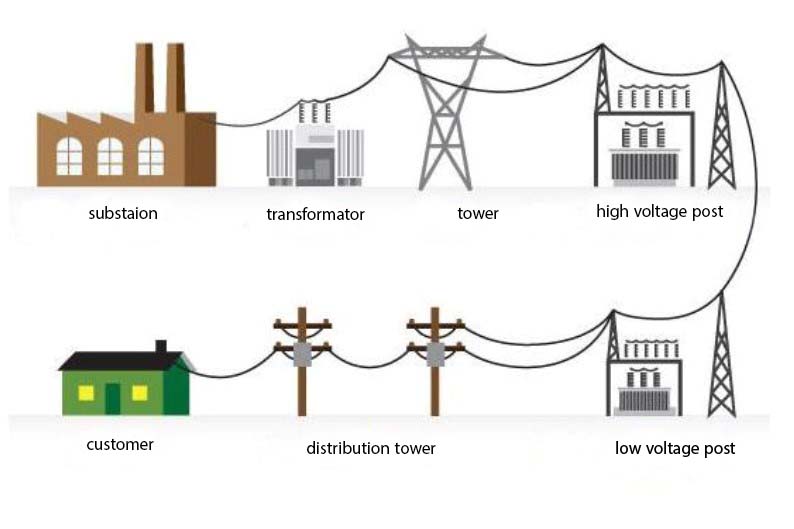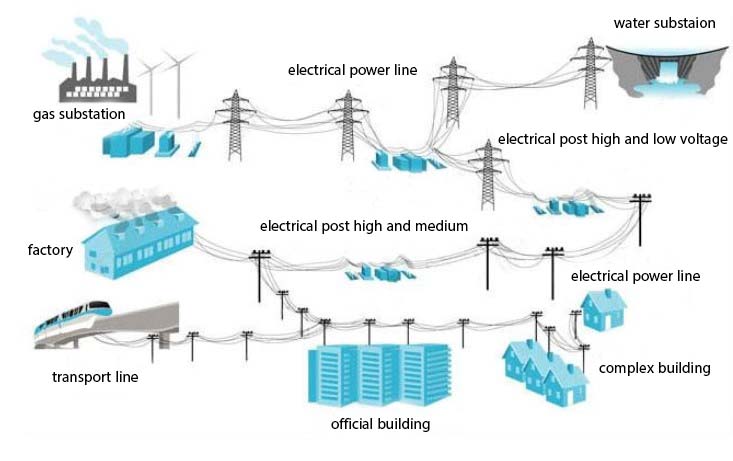Electricity industry is one of the most vital industries of a country. In the meantime, electrical energy distribution networks are the meeting point of the electricity industry subscribers, and the problems of the distribution system in this industry, from the consumers' point of view, will be considered the problem of the entire electricity industry. The increasing development, the lack of correct prediction of this process and the backwardness of technology have always brought problems in the electrical energy distribution system. Considering that 35% of the electricity industry's investments are related to the distribution sector, and lack of proper design, system guidance without planning and setting goals without project control, causes damage to the national capital, energy waste, dissatisfaction and pessimism of subscribers. has followed, therefore, the need for education and knowledge transfer, innovation, compliance with technical points and standards, monitoring, control and evaluation in distribution systems is strongly felt.
The need for attention and familiarity with the distribution of electrical energy
With every step taken in life, the dependence of human societies on electric energy sources is felt more; In the meantime, the connection between the power source and the consumers, called the energy distribution system, plays a vital role. This system is not only important in terms of the quantity of electrical energy distribution, but also in terms of the provision and continuity of electricity supply with valid standards in the desired quality.
Electric energy, in thermal power plants by fossil fuels, or after spending heavy expenses, using the water potential of dams in hydro turbines produced through energy transmission lines, is transferred to consumption centers. In these centers, the conversion stations reduce the voltage level. This average voltage will reach the consumer through the distribution networks. At the place of consumption, with the help of distribution transformer stations, the voltage is converted to a usable level for domestic, industrial, commercial, general, agricultural, etc. and consumed.

Power systems are responsible for providing electrical energy from production to consumption. These systems are divided into four main parts: production, transmission, distribution and customer service. Today, due to the wide range of activities of the electricity supply cycle in various stages of "production, transmission, distribution of electricity and after-sales services to customers", the need to pay more and more specific attention to each of these branches of the electricity industry has become more serious.
The necessity of training and using the expertise of manpower in each of these departments caused the Ministry of Energy to be divided into affiliated companies and organizations based on their type of activity. Of course, due to the great difference, these activities are usually managed by separate organizations.

At the beginning of the development of the use of electric energy, the distribution systems were often among power plants, and with the expansion of the use of electric energy, the demand for power distribution systems became more and more complex. These systems not only had to serve a large number of consumers, but also had to feed large individual loads, which nowadays require more careful monitoring and comprehensive design in terms of voltage drop and power quality with the ability It requires high reliability in service. Therefore, "power distribution engineering" is constantly faced with a wide range of issues, which itself has become a scientific branch in the field of electrical engineering in terms of economics, design, and scientific issues for optimal construction, repair, and operation. With the expansion of electricity use, the demands of consumers from power distribution systems became more and more diverse. These systems not only have to serve a large number of urban consumers, but they also have to cover individual loads such as industries and production workshops, agricultural water wells, remote rural areas, which in this case require There will be more careful monitoring and handling of the level of voltage changes in the branches of the subscribers. On the other hand, today's consumers demand such reliability from the service in which the frequency of power outages is less and the duration of blackouts is shorter. Therefore, paying attention to the design, construction, maintenance and maintenance of distribution systems has become an up-to-date scientific topic and there is an increasing need to comply with technical and economic principles in this branch of the electricity industry.
Development of distribution systems
Parallel to the development of electricity distribution networks, innovation in electrical devices, invention of very suitable materials, evolution of advanced equipment and tools, replaced and used day by day in a way that new and highly efficient techniques for repair, operation and construction Distribution networks, in order to establish an economic distribution system, the correct selection of the sizes of conductors, insulators, transformers and other components, caused a system with high reliability to require less emergency operations due to overloads and to In general, the facility is responsive to future demand. Losses will be reduced in such a system. On the other hand, new topics in the field of distribution systems such as consumption and load management, mechanization, distribution dispatching and remote control devices, digital and electronic systems in measurement and control have been introduced and built. All the mentioned cases promise the connection of the engineering of distribution networks with the improvement of the quality of electrical service as well as the reduction of losses and the optimal and automatic exploitation of the distribution system.

There are other factors that affect the design, construction and operation of distribution systems, while many of them are not of a technical nature, including economic-engineering issues that play the most important role in this field, issues Such as the rate of return on capital, the future value of current investments, as well as the present value of expenses in the future, inflation rate, financing issues, budget and taxes. Among other problems, we can mention the privacy of electric lines, land maintenance, cutting trees, and environmental issues. The growth pattern in the future, electricity tariff regulations and increasing consumer expectations, efforts to satisfy customers, supply and training of skilled and specialized human resources are required.
Since distribution engineers work with existing systems, it would be desirable to analyze the status of current facilities, improve and optimize them, and describe some changes and developments. Currently, most of the distribution systems are aerial, and regardless of the increase in terrestrial cable networks, aerial distribution systems will continue to be the same for some time.
The use of airlines has made it possible to use electricity to the farthest parts of the country. Today, the science of distribution engineering is surrounded by environmental factors, and more than ever, they seek innovation and innovation to solve this problem. In the new designs of aerial networks, in addition to complying with the existing standards, environmental factors are also considered in its design so that the structures of the distribution lines cause the least disturbance. In this context, even in advanced countries, it has been implemented to standardize the foundations of power distribution lines, telecommunication networks and road lighting networks on foundations with agreed heights for all types of conductors.